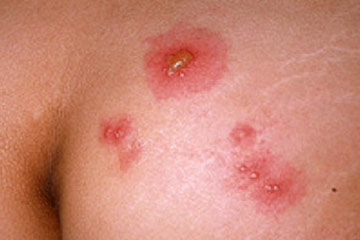Screening for Colorectal Cancer
The US Preventive Services Task Force (USPSTF) grades its recommendations (A, B, C, D, or I) and identifies the Levels of Certainty regarding Net Benefit (High, Moderate, and Low). The definitions of these grades can be found at the end of the "Major Recommendations" field.
Summary of Recommendations and Evidence
The USPSTF recommends screening for colorectal cancer using fecal occult blood testing, sigmoidoscopy, or colonoscopy, in adults, beginning at age 50 years and continuing until age 75 years. The risks and benefits of these screening methods vary. (See Rationale section of the original guideline document.) This is an A recommendation.
The USPSTF recommends against routine screening for colorectal cancer in adults 76 to 85 years. There may be considerations that support colorectal cancer screening in an individual patient. This is a C recommendation.
The USPSTF recommends against screening for colorectal cancer in adults older than age 85 years. This is a D recommendation.
The USPSTF concludes that the evidence is insufficient to assess the benefits and harms of computed tomographic colonography and fecal DNA testing as screening modalities for colorectal cancer. This is an I statement.
Clinical Considerations
Patient Population under Consideration
These recommendations apply to adults 50 years of age and older, excluding those with specific inherited syndromes (Lynch syndrome or familial adenomatous polyposis) and those with inflammatory bowel disease. The recommendations do apply to those with first-degree relatives who have had colorectal adenomas or cancer, although for those with first-degree relatives who developed cancer at a younger age, or with multiple affected first-degree relatives, an earlier start to screening may be reasonable. Data suggest that colorectal cancer has a higher mortality rate in African Americans. The reasons for this differential are not well known, and the recommendations are intended to apply to all ethnic and racial groups.
When the screening test results in the diagnosis of clinically significant colorectal adenomas or cancer, the patient will be followed by a surveillance regimen and recommendations for screening are no longer applicable. The USPSTF did not address evidence for the effectiveness of any particular surveillance regimen after diagnosis and/or removal of adenomatous polyps.
Screening Tests
The relative sensitivity and specificity of the different colorectal screening tests with adequate data to assess cancer detection—colonoscopy, flexible sigmoidoscopy, and fecal tests—can be depicted as follows:
Sensitivity: Hemoccult II < fecal immunochemical tests < Hemoccult SENSA < flexible sigmoidoscopy < colonoscopy
Specificity: Hemoccult SENSA < fecal immunochemical tests ≈ Hemoccult II < flexible sigmoidoscopy = colonoscopy
For the operator-dependent tests—flexible sigmoidoscopy, computed tomographic (CT) colonography, and colonoscopy—better operator training and more experience have a high likelihood of improving sensitivity. Approaches related to certification, such as quality standards and possibly minimum volume requirements, could be used to achieve the goal of improving operator performance and therefore test sensitivity. Assurance of performance of high-quality endoscopy should be part of all screening programs.
Since several screening strategies have similar efficacy, efforts to reduce colon cancer deaths should focus on implementation of strategies that maximize the number of individuals who get screening of some type. The different options for colorectal cancer screening tests are variably acceptable to patients; eliciting patient preferences is one step in improving adherence. Ideally, shared decision making between clinicians and patients would incorporate information on local test availability and quality as well as patient preference.
Screening Intervals and Starting and Stopping Ages
Screening for colorectal cancer reduces mortality through detection and treatment of early stage cancers and detection and removal of adenomatous polyps. The degree to which each of these mechanisms contributes to a reduction in mortality is unknown, though it is likely that the largest reduction in colorectal cancer mortality during the 10 years after initial screening comes from the detection and removal of early-stage cancers. Colonoscopy is a necessary step in any screening program that reduces mortality from colorectal cancer. This reduction in mortality does come at the expense of significant morbidity associated with colonoscopy. Evidence does not currently allow a differential estimate of colonoscopy-related morbidity for different age groups or for exams done with or without biopsy.
In this context, the best measure for the morbidity that results from any screening program for colorectal cancer is the number of colonoscopies required to achieve a reduction in mortality. Although improvements in mortality will generally be associated with increasing morbidity that results from the screening and surveillance program, the goal of a screening program should be to maximize the number of life-years gained while minimizing the harms.
In a report prepared for the USPSTF by 2 groups in the Cancer Intervention and Surveillance Modeling Network (CISNET), investigators conducted microsimulation analyses that applied programs of screening to standard populations of adults in the United States. These analyses permitted a comparison of expected outcomes among testing strategies involving the fecal tests, flexible sigmoidoscopy, or colonoscopy (as noted below). In the models, the predicted total number of colonoscopies included those resulting from surveillance after detection of colorectal neoplasia. The models assumed lifetime monitoring by colonoscopy every 3 to 5 years depending on the number and size of the adenomas detected. It is not the intent of the USPSTF to endorse this particular approach to surveillance, but standardizing the approach to surveillance is necessary to compare screening strategies in the models.
For all screening modalities, starting screening at age 50 resulted in a balance between life-years gained and colonoscopy risks that was more favorable than commencing screening earlier. Despite the increasing incidence of colorectal adenomas with age, for individuals previously screened the gain in life-years associated with extending screening from age 75 to 85 was small in comparison to the risks of screening people in this decade. For adults who have not previously been screened, decisions about first-time screening in this age group should be made in the context of the individual's health status and competing risks, given that the benefit of screening is not seen in trials until at least 7 years later. For individuals older than age 85, competing causes of mortality preclude a mortality benefit that outweighs the harms.
Screening programs incorporating fecal occult blood testing, sigmoidoscopy, or colonoscopy will all be effective in reducing mortality. Modeling evidence suggests that population screening programs between the ages of 50 and 75 using any of the following 3 regimens will be approximately equally effective in life-years gained, assuming 100% adherence to the same regimen for that period: 1) annual high-sensitivity fecal occult blood testing, 2) sigmoidoscopy every 5 years combined with high-sensitivity fecal occult blood testing every 3 years, and 3) screening colonoscopy at intervals of 10 years.
The strategies differ in the total number of colonoscopies that would be required to gain similar numbers of life-years. The first strategy, use of annual high-sensitivity fecal occult blood testing (sensitivity for cancer >70%) that has a false-positive rate less than 10% (that is, specificity >90%) is estimated to require the fewest colonoscopies while achieving a gain in life-years similar to that seen with screening colonoscopy every 10 years. Currently available tests that meet both specifications include SENSA guaiac testing (Beckman Coulter, Fullerton, California) and fecal immunochemical tests with characteristics similar to those of the Magstream quantitative test (Fujirebio Inc., Tokyo, Japan).
Although use of an annual fecal occult blood screening test with a lower sensitivity has been demonstrated to reduce colorectal cancer mortality in randomized, controlled trials, modeling suggests that the number of life-years gained will be greater with the strategies using higher-sensitivity tests.
For all screening modalities, the effectiveness decreases substantially as adherence to the regimen declines. At the individual level, adherence to a screening regimen will be more important in life-years gained than will the particular regimen selected. Current data are insufficient to predict adherence to any specific screening regimen at the population level.
Considerations for Practice When Evidence Is Insufficient
CT Colonography
Potential preventable burden. A screening program that incorporates the option of CT colonography could help reduce colorectal cancer mortality in the population if patients who would otherwise refuse screening found it an acceptable alternative.
Potential harms. The potential harms from evaluation of incidental findings found with CT colonography may be large. The lifetime cumulative radiation risk from use of CT colonography to screen for colorectal cancer should be considered, as well as the growing cumulative radiation exposure from the use of other kinds of diagnostic and screening that involve radiation exposure.
Current practice. Computed tomographic colonography performed by trained and experienced radiographers may not be currently available in many parts of the United States.
Costs. Patient time and burden to participate in colorectal cancer screening using test strategies that require bowel preparation are substantial. A CT colonography screening strategy that did not involve bowel preparation would decrease the burden of adherence. The cost of CT colonography is high.
Fecal DNA
Potential preventable burden. Fecal DNA has potential as a highly specific test, and it could reduce harms associated with follow-up of false-positive test results.
Current practice. Fecal DNA tests are evolving, and no test is widely used.
Costs. Fecal DNA is likely to have a high monetary cost per test.
Other Approaches to Prevention
Dietary approaches, such as avoidance of red meat and alcohol or consumption of diets very high in fiber, have been suggested to protect against the risk for colorectal adenomas, but these claims are based on associations present in observational studies that have thus far not been substantiated in trials. Certain nonsteroidal anti-inflammatory drugs (NSAIDs) are associated with regression and decreased incidence of colonic adenomas, but the harms of daily NSAID use in asymptomatic persons led the USPSTF to recommend against this use in persons not at increased risk.
Definitions:
What the United States Preventive Services Task Force (USPSTF) Grades Mean and Suggestions for Practice
| Grade | Grade Definitions | Suggestions for Practice |
|---|---|---|
| A | The USPSTF recommends the service. There is high certainty that the net benefit is substantial. | Offer or provide this service. |
| B | The USPSTF recommends the service. There is high certainty that the net benefit is moderate or there is moderate certainty that the net benefit is moderate to substantial. | Offer or provide this service. |
| C | The USPSTF recommends against routinely providing the service. There may be considerations that support providing the service in an individual patient. There is moderate or high certainty that the net benefit is small. | Offer or provide this service only if there are other considerations in support of the offering/providing the service in an individual patient. |
| D | The USPSTF recommends against the service. There is moderate or high certainty that the service has no net benefit or that the harms outweigh the benefits. | Discourage the use of this service. |
| I Statement | The USPSTF concludes that the current evidence is insufficient to assess the balance of benefits and harms of the service. Evidence is lacking, of poor quality or conflicting, and the balance of benefits and harms cannot be determined. | Read "Clinical Considerations" section of USPSTF Recommendation Statement (see "Major Recommendations" field). If offered, patients should understand the uncertainty about the balance of benefits and harms. |
Benefits/Harms of Implementing the Guideline Recommendations
Potential Benefits
Benefits of Detection and Early Intervention
- There is convincing evidence that screening with any of the 3 recommended tests reduces colorectal cancer mortality in adults age 50 to 75 years. Follow-up of positive screening test results requires colonoscopy regardless of the screening test used. Because of the harms of colonoscopy described below, the chief benefit of less invasive screening tests is that they may reduce the number of colonoscopies required and their attendant risks.
- There is adequate evidence that the benefits of detection and early intervention decline after age 75. There is a substantial lead time between the detection and treatment of colorectal neoplasia and a mortality benefit, and competing causes of mortality make it progressively less likely that this benefit will be realized with advancing age.
Harms of Detection and Early Intervention
The primary established harms of colorectal cancer screening are due to the use of invasive procedures initially or in the evaluation sequence. Harms may arise from the preparation the patient undergoes to have the procedure, the sedation used during the procedure, and the procedure itself.
Colonoscopy
Evidence is adequate to estimate the harms of colonoscopy. In the United States, perforation of the colon occurs in an estimated 3.8 per 10,000 procedures. Serious complications—defined as deaths attributable to colonoscopy or adverse events requiring hospital admission, including perforation, major bleeding, diverticulitis, severe abdominal pain, and cardiovascular events—are significantly more common, occurring in an estimated 25 per 10,000 procedures.
Flexible Sigmoidoscopy
Evidence is adequate that serious complications occur in approximately 3.4 per 10,000 procedures.
Fecal Tests
Evidence about the harms of fecal tests is lacking (inadequate), but the U.S. Preventive Services Task Force (USPSTF) assesses them to be no greater than small.
Computed Tomographic (CT) Colonography
- Computed tomographic colonography images more than the colon. At least 10% of people having their first CT colonography are found to have extracolonic abnormalities that require further testing. Evidence is inadequate to assess the clinical consequences of identifying these abnormalities, but there is potential for both benefit and harm. Potential harms arise from additional diagnostic testing and procedures for lesions found incidentally, which may have no clinical significance. This additional testing also has the potential to burden the patient and adversely impact the health system.
- The risks for perforation associated with CT colonography in research settings are estimated to be 0 to 6 per 10,000 CT colonography studies. However, these estimates may be higher than what can be expected in screened populations because the studies included symptomatic populations.
- Radiation exposure resulting from CT colonography is reported to be 10 mSv per examination. The harms of radiation at this dose are not certain, but the linear-no-threshold model predicts that 1 additional individual per 1000 would develop cancer in his or her lifetime at this level of exposure. The lifetime cumulative radiation risk from the use of CT colonography to screen for colorectal cancer should be considered in the context of the growing cumulative radiation exposure from the use of other diagnostic and screening tests that involve radiation exposure. On the other hand, improvements in CT colonography technology and practice are lowering this radiation dose.
Source
Screening for colorectal cancer: U.S. Preventive Services Task Force recommendation statement.
National Guideline Clearinghouse






